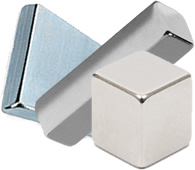Magnets are right up there with casters, hinges, and Latches as something we use every day without noticing. Like those items the magnet is likely older than Humankinds ability to write about them. The Magnet of today is a direct descendant of the naturally occurring Mineral Lodestone. This naturally magnetic ore was not formerly called magnetite until 1845. The word magnet is much older than that. The Ancient Greek Pliny the Elder wrote of a legend with the Shephard “Magnes” finding the nails of his shoes attracted to Lodestone.
There was a city named Magnesia famous for its lodestone. There was a tribe of peoples known as “Magnet Macedonians”. Regardless of how it came to be named the Magnet as we know it today was not invented more than it was discovered. At some point someone put a sliver of lodestone on a bit of cork and noticed it always aligned itself in a specific direction. Around 500 BC the Chinese developed a south pointing compass.
While humans could travel the oceans using the stars and the sun for direction. The compass changed everything. Whether on land or sea, an explorer could plot a compass course to not only get somewhere but find the way back. In a bit of Irony, the early users of the compass had no clue as to why or how it did what it did. Even the Greeks assigned magnetism a certain human quality because it affected the things around it without touching them.
The Magnet in the form of Lodestar mineral lived in the compass from about 600 BC to the late 1500’s. It was the scientific revolution that gave us the process and tools to truly study magnetism. In the 1600’s William Gilbert was the first to publish works with an understanding of how magnets work and why.

Gilbert was the first to Identify the magnetic field, the first to understand earth as a giant magnet, and his use of the Latin word electricus became our electricity. What Gilbert did not do was find the relationship between electricity and magnetism. In the 1700’s Franklin was flying his kite and the understanding of electricity grew. It was 1820 when the Danish Physicist Oersted put an electric current near a compass and found the compass pointed that way. After this, the understanding of electromagnetism was a key enabler of the industrial revolution.
The world today would be a different place without our understanding of magnetism. The early 1900’s saw the refinement of magnet Production. By 1930 different minerals and combinations like Cobalt and Alnico were joined to greatly increase the strength of magnets. Smaller and smaller magnets were produced that were able to exert more and more force.
By 1960 “rare earth” magnets were invented and in 1983 came General Motors with the magnet recipe most in use today, a combination of Neodymium, Iron, and Boron. Today the understanding of magnetism drives everything from space travel to the latch on your kitchen cupboard. Because of this, magnets are an industrial commodity used by the billions. From a sliver of ore on a cork that led early exploration to our understanding of the universe, the magnet is a natural wonder developed by humankind for the benefit of all.

